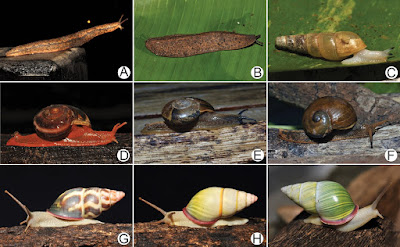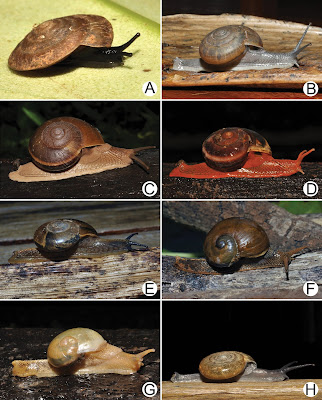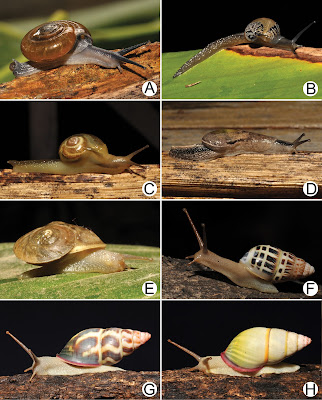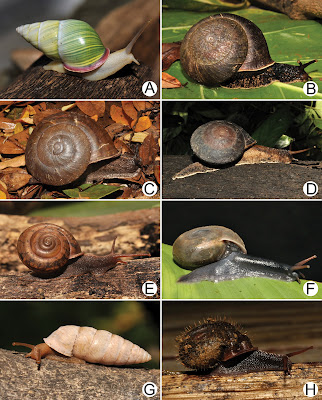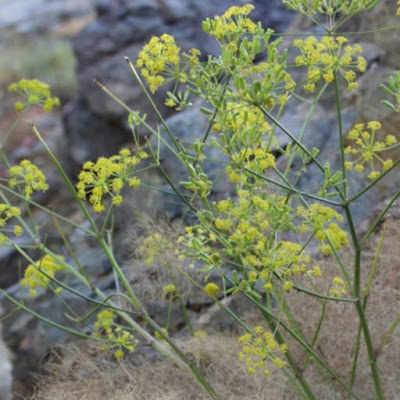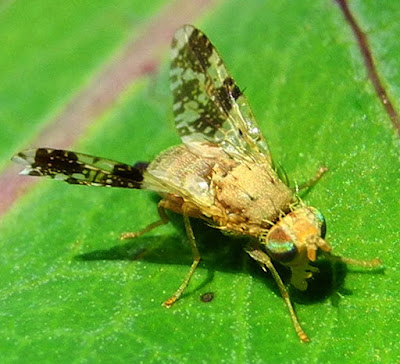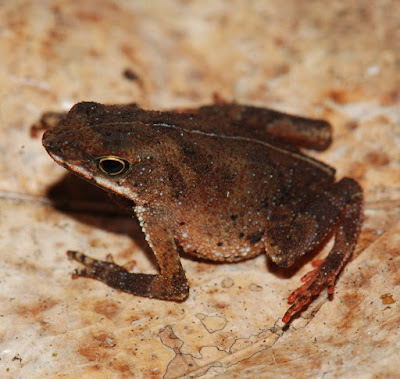[Most Recent Entries] [Calendar View]
Monday, April 15th, 2019
| Time | Event | ||
| 1:01p | [Gastropoda • 2019] Annotated Checklist of the Terrestrial Molluscs (Mollusca, Gastropoda) from Laos Abstract The land area of Laos is composed of a large variety of undisturbed habitats, such as high mountainous areas, huge limestone karsts and the lower Mekong Basin. Therefore, Laos is expected to have a high species diversity, especially for the land snails. However, with respect to research on malacology, Laos is probably the least well-researched area for land snail diversity in Indochina (including Laos) over the past few centuries. The handful of species lists have never been systematically revised from the colonial period to the present, so these classifications are outdated. Herein we present the first comprehensive annotated checklist with an up-to-date systematic framework of the land snail fauna in Laos based on both field investigations and literature surveys. This annotated checklist is collectively composed of 231 nominal species (62 ‘prosobranch’ and 169 heterobranches), of which 221 nominal species are illustrated. The type specimens of 143 species from several museum collections and/or 144 species of newly collected specimens are illustrated. There are 58 species recorded as new to the malacofauna of the country, and two new replacement names are proposed as Hemiplecta lanxangnica Inkhavilay and Panha, nomen novum (Ariophantidae) and Chloritis khammouanensis Inkhavilay and Panha, nomen novum (Camaenidae). Four recently described species of the genus Amphidromus from Laos, “thakhekensis”, “richgoldbergi”, “attapeuensis” and “phuonglinhae” are synonymized with previously described species. In addition, thirteen nominal species are listed as uncertain records that may or may not occur in Laos. This annotated checklist may inspire malacologists to carry on systematic research in this region. Keywords: Biodiversity, conservation, land snail, type specimen, Southeast Asia, new name, Indochina
Khamla Inkhavilay, Chirasak Sutcharit, Ueangfa Bantaowong, Ratmanee Chanabun, Warut Siriwut, Ruttapon Srisonchai, Arthit Pholyotha, Parin Jirapatrasilp and Somsak Panha. 2019. Annotated Checklist of the Terrestrial Molluscs from Laos (Mollusca, Gastropoda). ZooKeys. 834: 1-166. DOI: 10.3897/zookeys.834.28800 | ||
| 1:03p | [Botany • 2019] Prangos aricakensis (Apiaceae) • A New Species from eastern Turkey
Abstract Prangos aricakensis is described and illustrated as a new species from eastern Anatolia (Turkey), where it is known from a single locality in Arıcak (Elazığ) district. Its diagnostic characters are discussed and taxonomic comments are presented. Prangos aricakensis is similar to P. turcica, P. hulusii, P. ilanae and P. trifida, but it differs in hair, leaf, bract, bracteole and fruit characteristics. Fruit and pollen characteristics were investigated using ligth (LM) and scanning electron microscopy (SEM). Data on ecology and IUCN conservation status are also shown. Keywords: Eastern Anatolia, endemics, Mediterranean flora, Prangos, taxonomy, Umbelliferae, Eudicots Prangos aricakensis Lütfi Behçet, Yakup Yapar and Şükrü Olgun. 2019. Prangos aricakensis (Apiaceae), A New Species from eastern Turkey. Phytotaxa. 401(1); 55–63. DOI: 10.11646/phytotaxa.401.1.5 | ||
| 1:13p | [Entomology • 2019] Revision of the Old World Species of the Genus Tephritis (Diptera, Tephritidae) with A Pair of Isolated Apical Spots Abstract Species of the genus Tephritis usually have the wing pattern with dark rays on veins R4+5 and M connected to the preapical dark spot or to each other (often called the “apical fork). Some species, however, have a solid apical crossband (Korneyev, 2013), whereas others have an isolated pair of apical spots. Specimens with the latter morphological character occasionally occur in many species with typical wing patterns, but in this article we focus on the species that normally have it. They occur mostly in the Palaearctic Region, except T. candidipennis Foote, 1960 from North America. A total of twenty species are recognized in this complex, including three new species and two new subspecies: Tephritis arsenii S. Korneyev, 2015, T. bardanae (Schrank 1803), T. conyzifoliae Merz 1992, T. crepidis Hendel 1927, T. dilacerata (Loew 1846), T. dilacerata kaszabi new subspecies, T. formosa (Loew 1844), T. ghissarica new species, T. hendeliana Hering 1944, T. hyoscyami (Linnaeus 1758), T. kyrghyzica new species, T. kogardtauica Hering 1944, T. kovalevi Korneyev & Kameneva 1990, T. kovalevi kumana new subspecies; T. postica (Loew 1844), T. stictica Loew 1862, T. theryi Séguy 1930, T. tridentata S. Korneyev & Mohamadzade-Namin 2013, T. truncata (Loew 1844), T. valida (Loew 1862), T. youngiana new species, and T. zernyi Hendel 1927. Most of the species are keyed, redescribed and illustrated based on extensive material from the Palaearctic Region. Lectotypes of T. dilacerata, T. formosa, T. hendeliana, T. truncata, T. valida, T. posis, T. heiseri, T. procera and a neotype for T. postica are designated. Known host plants of this complex belong to the tribes Anthemideae, Cardueae, Cichorieae, Inuleae, and Senecioneae (Asteraceae); preliminary comparison of the morphological characters (other than the wing pattern) with the distribution among host plants shows that the flies apparently do not form a monophyletic group, belonging to several different lineages, which also include other species with the typical “forked wing pattern. New distribution records and host plants are reported. The following synonymies are established: Musca hyoscyami Linnaeus 1758 = Tephritis heiseri Frauenfeld 1865 new synonym; Trypeta postica Loew 1844 = Tephritis posis Hering 1939 new synonym. Keywords: Diptera, Tephritidae, Tephritis, new species, new subspecies, new synonym, key, distribution, lectotype designation Severyn V. Korneyev and Valery A. Korneyev. 2019. Revision of the Old World Species of the Genus Tephritis (Diptera, Tephritidae) with A Pair of Isolated Apical Spots. Zootaxa. 4584(1); 1–73. DOI: 10.11646/zootaxa.4584.1.1 | ||
| 1:25p | [Herpetology • 2019] Amazophrynella bilinguis • A New Species of Amazophrynella (Anura: Bufonidae) from Brazilian Amazonia, with Two Distinct Advertisement Calls
Abstract Here we describe a new species of the toad genus Amazophrynella (Bufonidae) from the south margin of the Amazon River in Santarém, state of Pará, Brazilian Amazonia. The new species can be diagnosed by (1) medium body size for the genus: adult females 19.5–20.4 mm SVL, adult males 13.0–14.5 mm SVL; (2) snout acuminate in lateral view; (3) Finger I larger and robust; (4) Finger I nearly equal in size than Finger II; (5) palmar tubercle rounded, covering ¼ of hand; (6) pigmented callus in Finger I in males; in life: (7) brown stain on throat and chest; (8) black dots on venter. Males emit two distinct advertisement calls: the call type 1 consists of a relatively long note (mean 0.248 s) with a mean dominant frequency of 3526 Hz. The call type 2 is arranged in bouts of 6 to 22 notes with mean dominant frequency of 3450 Hz and much shorter note durations (mean 0.034 s). In this study we also redescribe the advertisement call of A. minuta, which also emits a second call type. Keywords: Amphibia, Amazonia, bioacoustics, mtDNA, Pará, Santarém Amazophrynella bilinguis Igor Luis Kaefer, Rommel R. Rojas, Miquéias Ferrão, Izeni Pires Farias and Albertina Pimentel Lima. 2019. A New Species of Amazophrynella (Anura: Bufonidae) with Two Distinct Advertisement Calls. Zootaxa. 4577(2); 316–334. DOI: 10.11646/zootaxa.4577.2.5 |
| << Previous Day |
2019/04/15 [Calendar] |
Next Day >> |
